#when I tell you Adelaide and I died of hysterical laughter
Explore tagged Tumblr posts
Text
*Adelaide and I are watching Agatha All Along*
Agatha: Who’s here with us?*
Ouija board: M-R-S-H-A-R-T
. . .
Me: . . . Mr. Shart?
. . .
Agatha: Mrs. Hart!
#when I tell you Adelaide and I died of hysterical laughter#I mean absolutely reduced ourselves to ashes#I still can’t think about it without giggling#*I don’t really remember exactly what she says to prompt this so I paraphrased
43 notes
·
View notes
Text
Quilty as charged: Ben Quilty exhibition bridges the wonderful and the abhorrent
Quilty is the biggest show in town, as John Neylon reviews the first major survey of Ben Quiltys work. Churchill described success as stumbling from failure to failure with no loss of enthusiasm. Now why should that thought come to mind when reflecting on the art of Ben Quilty? By any measure, his progress to date has been entirely successful. The artist won in 2011 the Archibald Prize for his portrait of Margaret Olley and in 2009 the Doug Moran National Portrait Prize for a painting of Jimmy Barnes. He was awarded a Brett Whiteley Travelling Art Scholarship in 2002. He has presented a significant number of solo exhibitions and been included in many survey exhibitions and biennials. His work is held in the National Gallery collection and those of almost all Australian state art museums. Most recently, he has been honoured with a major survey show, Quilty, recently launched at the Art Gallery of South Australia (curated by Lisa Slade). The exhibition will subsequently tour to Art Gallery NSW and Queensland Art Gallery. Critic John McDonalds eye brow raise on the AGNSWs feting of Quilty, aged 46 (when senior artists Charles Blackman and Robert Dickerson both died without a retrospective in their home city), makes interesting reading. Then again, no other artist bar Brett Whiteley has been given the honorific of an opera based on their life and work. The Australian Opera production of Whiteley will be staged at the Sydney Opera House. But if Quiltys trajectory maintains its upward thrust, he may one day be so celebrated. A recent photo shoot (Good Weekend cover) showing the artist in Pasolini pose with a barbed wire crown might give a hint of how some librettist may one day mythologise him.
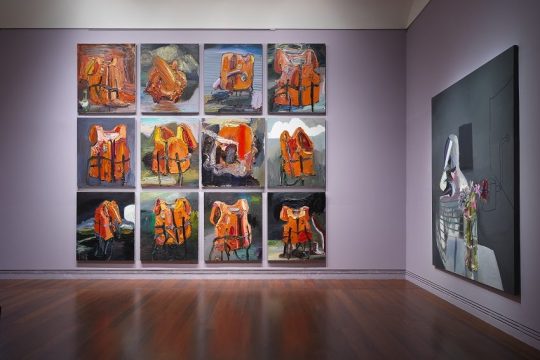
Installation view: Quilty, Art Gallery of South Australia, Adelaide, 2019 (Photo: Grant Handcock) This is an impressive level of recognition for a creative talent that has barely begun to hit its stride. Add to this the loosening of the art worlds grip on the Quilty narrative as the wider Australian community picks up the story and claims the artist as one of its own. This is rare but it does happen. Tom Roberts and Arthur Streeton, then Hans Heysen, gave expression to a sense of national identity through pastoral landscape. Sidney Nolan and Arthur Boyd gave utterance to the soul of a nation beginning to reflect on its inner life. Brett Whiteley riffed off 1960s counter culture vibes and Kathleen Petyarre created magic carpets of country that invited the nation to get on board. A sense that Ben Quilty may be destined (or expected) to face such a responsibility was evident at this years Adelaide Writers Week when the artist held a large crowd captive with his articulate description of how he sees his practice relating to wider community issues and aspirations. The audience was primed. Through extensive media exposure his credentials as an activist artist became well-known. In 2011 he worked as an Official War Artist with Australian troops in Afghanistan and subsequently created a compelling series of portraits of service men and women grappling with the trauma of what theyd experienced. His well-known life vest series came from the experience of witnessing refugee camps in the Lebanese Beqaa Valley and of walking life vest-strewn beaches on the Greek Islands of Lesbos and Chios. Then there was the close association with Muryan Sukamaran who was sentenced to death for drug trafficking in Indonesia. Audiences for Quilty the exhibition will be well served by a comprehensive representation of such images and a solid representation of formative work such as the cars and budgies which declare the artists mordant wit and subscription to bold gestural painting. But far more lies in wait, particularly the interlocking and tangled compositions associated with the Last Supper series.
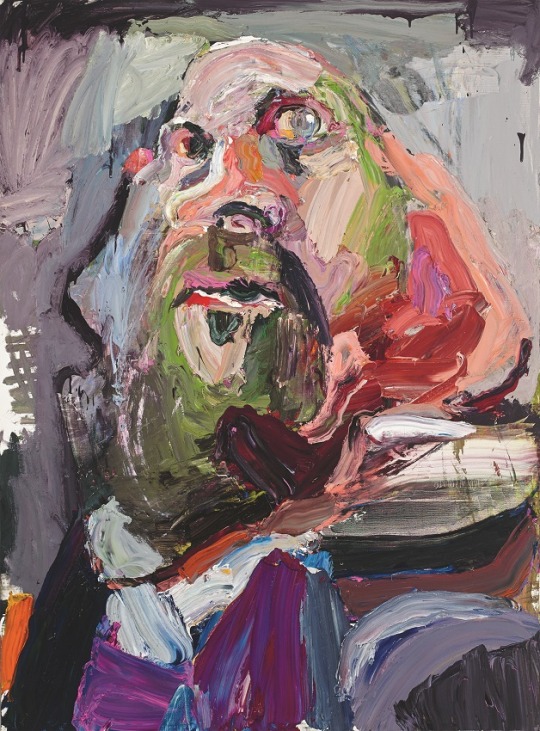
Self Portrait, the executioner, Ben Quilty, 2015, Southern Highlands, New South Wales, oil on linen, 195.0 x 140.4 cm; Gift of the artist 2015. Donated through the Australian Governments Cultural Gifts Program, Art Gallery of New South Wales, Sydney (Photo: Mim Stirling) There are some safer havens in the form of Rorschach blot-mediated images, particularly the familiarity of The Island, seen in Dark Heart, the 2014 Adelaide Biennial of Australian Art, Evening Shadows Rorschach after Johnstone (a somber riff off AGSAs most popular painting of all time Evening shadows backwater of the Murray, South Australia) and, another panoramic work, Fairy Bower Rorschach. In the light of recent media focus on massacre sites in Australia, this particular work, referencing such a site, an idyllic picnic ground on Gundungarra country where in 1834 Aboriginal women and children were reputedly massacred, sends a chill through the room. These works are visually engaging even if they hold their dark secrets close to their hearts. Viewers I noticed spent real time looking at them as if engaged in a Wheres Wally? battle of wits to find the hidden details. These images help to explain Quiltys sustained use of the Rorschach blotting technique of transferring, by folding and pressing, a positive image of thick, wet paint onto the other (blank) half of the canvas. As any respectable Rorschach blot will tell you, its all in the mind. But in the company of other works dwelling on hurt and misery they carry out their duties as gates to hell with disconcerting ease. The Rorschach spin is useful as a slingshot into the grotesque which, in Quiltys imagery, acts as circuit breaker between the wonderful and the abhorrent. Every time he distorts a face to breaking point or subjects a figure to dismemberment there is an appeal to ones inner sense of dread and the voyeur within. Whenever a head or a landscape pulls apart to morph into a Siamese-twin-like thing the grotesque comes sniffing around. From another perspective this recourse to the grotesque as a default within Quiltys imagery may act as an escape valve to relieve what must be for the artist a build-up of almost unbearable tension as he coopts his feelings to the tasks at hand. The grotesque always threatens to erupt as hysterical laughter. In a number of works, particularly faces with extruded noses and goggle eyes, the shriek of horror comes from the lips of Shrek, the unlikely hero. Time for Samuel Johnson, He who makes a beast of himself gets rid of the pain of being a man. This extensive exhibition, with its mid-section line-up of large-scale works that tend to tower over the viewer, oozes with visceral, oleaginous energy. We are not, as a rule, used to dealing with very large paintings, particularly figurative images calling down fire and brimstone on the worst the world serves up. Australian artist Richard Lewers The History of Australia is another, recent example. From an historical perspective, consider the status of the big picture in the Victorian era when panoramic vistas of everyday life by William Powell Frith, such as The Derby Day and The Railway Station, drew large crowds. In the modern era, some in Adelaide may recall being transfixed by the Hiroshima Panels, exhibited at the Art Gallery of South Australia in 1958. So, in one sense, Quilty is winding back the hands of the clock to a time when large paintings (and any paintings for that matter) addressed matters of social concern. The way-points in this reverse journey are many, so perhaps stop at Goya or youll be crushed by it all. My recommendation take a good hard look at Thodore Gricaults The Raft of the Medusa before climbing down into the darkened chambers of Quiltys Dantean journey into the mind. Medusa throws up the same questions: why them not us? Will justice be served?
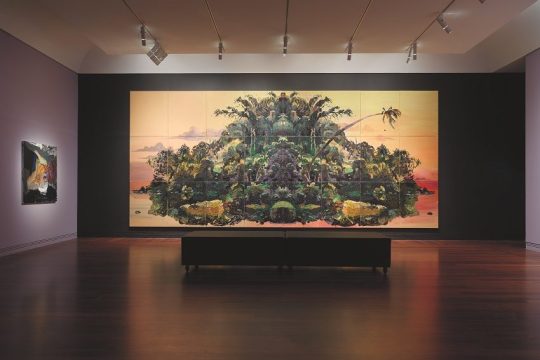
Installation view: Quilty featuring Self-portrait at 43 and The island by Ben Quilty, Art Gallery of South Australia, Adelaide, 2019 (Photo: Grant Handcock) From here, segue to the gate-keeper of modernitys limner of the human condition, Francis Bacon, who, when he visited a butchers shop, thought it surprising that I wasnt there instead of the animal. Look out for some Bacon references in the bared teeth of one self-portrait. If curious about this ambient link between Quiltys and Bacons agendas, consider this observation by artist Stacy Makishi. In my response to Francis Bacon, I wanted to push my explorations toward finding a transgressive kind of beauty. I wished to paint a muscular poem; a wet poem with saliva, sweat, tears and body fluids a poem that pushed ones body through a glass of forbidden desire. Pushing ones body resonates with Quilty (the exhibition publication) essayist Justin Pattons comment that the artist likes to chase the moment when his forms begin to push back. And thats what his monumental Last Supper images do when their interlocking sweeps of pigment and advancing/receding planes of colours and shapes (looking like a gelati Leger painting sliding towards the footpath) trap the gaze and hold it. Abandon all expectations of subject or social concern (as in the nearby feral polemic (Patton again)) of Quiltys rage at Trumps ascension, and surrender to the paint and the rush of creating something that is primarily about and of itself. In this regard, Quiltys priorities and methodologies line up with artist Robert Motherwells take on arts end game. For him it was all about managing feeling. To find and invent objects whose felt quality satisfies the passions that for me is the activity of the artist No wonder the artist is constantly placing and displacing, relating and rupturing relations veering towards the unknown and chaos yet ordered and related in order to be comprehended. There is art world commentary on the Quilty dilemma the risks of overpowering the art with the polemic and so on. While the artist continues to follow where the medium leads there is every chance that his creative journey will continue to be sustained. So back to the paint and Churchill. The walls of paint overpower almost every other consideration in this exhibition. Perhaps the best analogy to leave you with is that of the solo climber, clinging to the sheer rock wall with only the pressure of a thumb or a toe between the climber and death. In this situation the risks are beyond comprehension. No. Ben Quilty isnt facing such life and death decisions whenever he goes in to the studio. But the manner in which he traverses his canvases is high risk, with the thought of failure always needing to be countered by boundless enthusiasm.
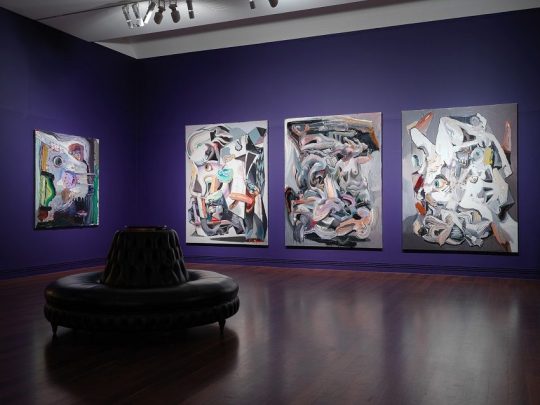
Installation view: Quilty, Art Gallery of South Australia, Adelaide, 2019 (Photo: Grant Handcock) Quilty Art Gallery of South Australia Until Sunday, June 2 agsa.sa.gov.au https://www.adelaidereview.com.au/arts/visual-arts/ben-quilty-exhibition-review/
0 notes
Text
Quilty as charged: Ben Quilty exhibition bridges the wonderful and the abhorrent
Quilty is the biggest show in town, as John Neylon reviews the first major survey of Ben Quiltys work. Churchill described success as stumbling from failure to failure with no loss of enthusiasm. Now why should that thought come to mind when reflecting on the art of Ben Quilty? By any measure, his progress to date has been entirely successful. The artist won in 2011 the Archibald Prize for his portrait of Margaret Olley and in 2009 the Doug Moran National Portrait Prize for a painting of Jimmy Barnes. He was awarded a Brett Whiteley Travelling Art Scholarship in 2002. He has presented a significant number of solo exhibitions and been included in many survey exhibitions and biennials. His work is held in the National Gallery collection and those of almost all Australian state art museums. Most recently, he has been honoured with a major survey show, Quilty, recently launched at the Art Gallery of South Australia (curated by Lisa Slade). The exhibition will subsequently tour to Art Gallery NSW and Queensland Art Gallery. Critic John McDonalds eye brow raise on the AGNSWs feting of Quilty, aged 46 (when senior artists Charles Blackman and Robert Dickerson both died without a retrospective in their home city), makes interesting reading. Then again, no other artist bar Brett Whiteley has been given the honorific of an opera based on their life and work. The Australian Opera production of Whiteley will be staged at the Sydney Opera House. But if Quiltys trajectory maintains its upward thrust, he may one day be so celebrated. A recent photo shoot (Good Weekend cover) showing the artist in Pasolini pose with a barbed wire crown might give a hint of how some librettist may one day mythologise him.
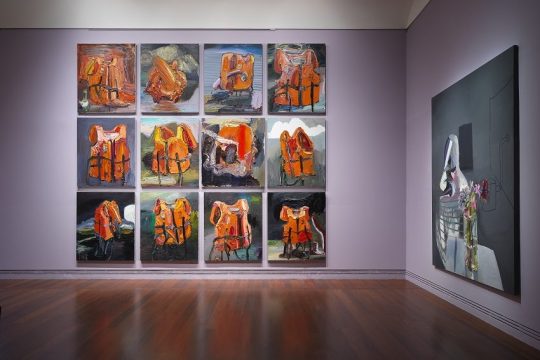
Installation view: Quilty, Art Gallery of South Australia, Adelaide, 2019 (Photo: Grant Handcock) This is an impressive level of recognition for a creative talent that has barely begun to hit its stride. Add to this the loosening of the art worlds grip on the Quilty narrative as the wider Australian community picks up the story and claims the artist as one of its own. This is rare but it does happen. Tom Roberts and Arthur Streeton, then Hans Heysen, gave expression to a sense of national identity through pastoral landscape. Sidney Nolan and Arthur Boyd gave utterance to the soul of a nation beginning to reflect on its inner life. Brett Whiteley riffed off 1960s counter culture vibes and Kathleen Petyarre created magic carpets of country that invited the nation to get on board. A sense that Ben Quilty may be destined (or expected) to face such a responsibility was evident at this years Adelaide Writers Week when the artist held a large crowd captive with his articulate description of how he sees his practice relating to wider community issues and aspirations. The audience was primed. Through extensive media exposure his credentials as an activist artist became well-known. In 2011 he worked as an Official War Artist with Australian troops in Afghanistan and subsequently created a compelling series of portraits of service men and women grappling with the trauma of what theyd experienced. His well-known life vest series came from the experience of witnessing refugee camps in the Lebanese Beqaa Valley and of walking life vest-strewn beaches on the Greek Islands of Lesbos and Chios. Then there was the close association with Muryan Sukamaran who was sentenced to death for drug trafficking in Indonesia. Audiences for Quilty the exhibition will be well served by a comprehensive representation of such images and a solid representation of formative work such as the cars and budgies which declare the artists mordant wit and subscription to bold gestural painting. But far more lies in wait, particularly the interlocking and tangled compositions associated with the Last Supper series.
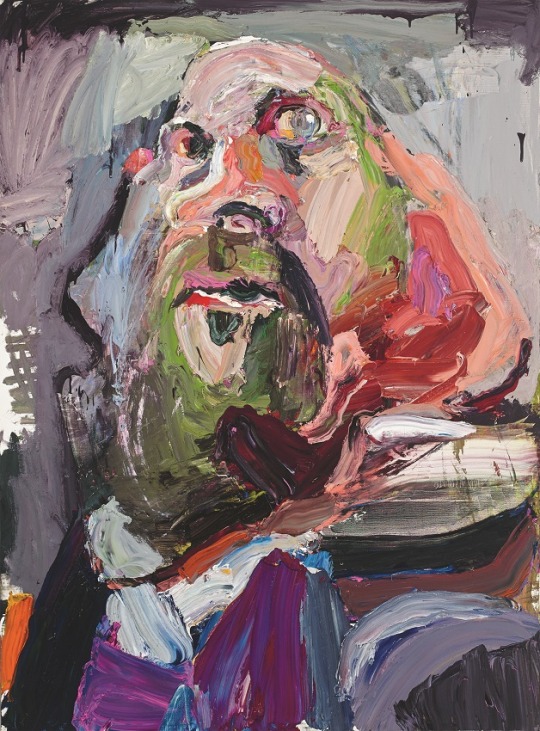
Self Portrait, the executioner, Ben Quilty, 2015, Southern Highlands, New South Wales, oil on linen, 195.0 x 140.4 cm; Gift of the artist 2015. Donated through the Australian Governments Cultural Gifts Program, Art Gallery of New South Wales, Sydney (Photo: Mim Stirling) There are some safer havens in the form of Rorschach blot-mediated images, particularly the familiarity of The Island, seen in Dark Heart, the 2014 Adelaide Biennial of Australian Art, Evening Shadows Rorschach after Johnstone (a somber riff off AGSAs most popular painting of all time Evening shadows backwater of the Murray, South Australia) and, another panoramic work, Fairy Bower Rorschach. In the light of recent media focus on massacre sites in Australia, this particular work, referencing such a site, an idyllic picnic ground on Gundungarra country where in 1834 Aboriginal women and children were reputedly massacred, sends a chill through the room. These works are visually engaging even if they hold their dark secrets close to their hearts. Viewers I noticed spent real time looking at them as if engaged in a Wheres Wally? battle of wits to find the hidden details. These images help to explain Quiltys sustained use of the Rorschach blotting technique of transferring, by folding and pressing, a positive image of thick, wet paint onto the other (blank) half of the canvas. As any respectable Rorschach blot will tell you, its all in the mind. But in the company of other works dwelling on hurt and misery they carry out their duties as gates to hell with disconcerting ease. The Rorschach spin is useful as a slingshot into the grotesque which, in Quiltys imagery, acts as circuit breaker between the wonderful and the abhorrent. Every time he distorts a face to breaking point or subjects a figure to dismemberment there is an appeal to ones inner sense of dread and the voyeur within. Whenever a head or a landscape pulls apart to morph into a Siamese-twin-like thing the grotesque comes sniffing around. From another perspective this recourse to the grotesque as a default within Quiltys imagery may act as an escape valve to relieve what must be for the artist a build-up of almost unbearable tension as he coopts his feelings to the tasks at hand. The grotesque always threatens to erupt as hysterical laughter. In a number of works, particularly faces with extruded noses and goggle eyes, the shriek of horror comes from the lips of Shrek, the unlikely hero. Time for Samuel Johnson, He who makes a beast of himself gets rid of the pain of being a man. This extensive exhibition, with its mid-section line-up of large-scale works that tend to tower over the viewer, oozes with visceral, oleaginous energy. We are not, as a rule, used to dealing with very large paintings, particularly figurative images calling down fire and brimstone on the worst the world serves up. Australian artist Richard Lewers The History of Australia is another, recent example. From an historical perspective, consider the status of the big picture in the Victorian era when panoramic vistas of everyday life by William Powell Frith, such as The Derby Day and The Railway Station, drew large crowds. In the modern era, some in Adelaide may recall being transfixed by the Hiroshima Panels, exhibited at the Art Gallery of South Australia in 1958. So, in one sense, Quilty is winding back the hands of the clock to a time when large paintings (and any paintings for that matter) addressed matters of social concern. The way-points in this reverse journey are many, so perhaps stop at Goya or youll be crushed by it all. My recommendation take a good hard look at Thodore Gricaults The Raft of the Medusa before climbing down into the darkened chambers of Quiltys Dantean journey into the mind. Medusa throws up the same questions: why them not us? Will justice be served?

Installation view: Quilty featuring Self-portrait at 43 and The island by Ben Quilty, Art Gallery of South Australia, Adelaide, 2019 (Photo: Grant Handcock) From here, segue to the gate-keeper of modernitys limner of the human condition, Francis Bacon, who, when he visited a butchers shop, thought it surprising that I wasnt there instead of the animal. Look out for some Bacon references in the bared teeth of one self-portrait. If curious about this ambient link between Quiltys and Bacons agendas, consider this observation by artist Stacy Makishi. In my response to Francis Bacon, I wanted to push my explorations toward finding a transgressive kind of beauty. I wished to paint a muscular poem; a wet poem with saliva, sweat, tears and body fluids a poem that pushed ones body through a glass of forbidden desire. Pushing ones body resonates with Quilty (the exhibition publication) essayist Justin Pattons comment that the artist likes to chase the moment when his forms begin to push back. And thats what his monumental Last Supper images do when their interlocking sweeps of pigment and advancing/receding planes of colours and shapes (looking like a gelati Leger painting sliding towards the footpath) trap the gaze and hold it. Abandon all expectations of subject or social concern (as in the nearby feral polemic (Patton again)) of Quiltys rage at Trumps ascension, and surrender to the paint and the rush of creating something that is primarily about and of itself. In this regard, Quiltys priorities and methodologies line up with artist Robert Motherwells take on arts end game. For him it was all about managing feeling. To find and invent objects whose felt quality satisfies the passions that for me is the activity of the artist No wonder the artist is constantly placing and displacing, relating and rupturing relations veering towards the unknown and chaos yet ordered and related in order to be comprehended. There is art world commentary on the Quilty dilemma the risks of overpowering the art with the polemic and so on. While the artist continues to follow where the medium leads there is every chance that his creative journey will continue to be sustained. So back to the paint and Churchill. The walls of paint overpower almost every other consideration in this exhibition. Perhaps the best analogy to leave you with is that of the solo climber, clinging to the sheer rock wall with only the pressure of a thumb or a toe between the climber and death. In this situation the risks are beyond comprehension. No. Ben Quilty isnt facing such life and death decisions whenever he goes in to the studio. But the manner in which he traverses his canvases is high risk, with the thought of failure always needing to be countered by boundless enthusiasm.
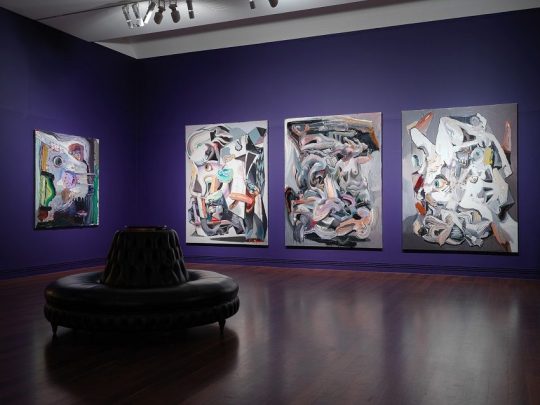
Installation view: Quilty, Art Gallery of South Australia, Adelaide, 2019 (Photo: Grant Handcock) Quilty Art Gallery of South Australia Until Sunday, June 2 agsa.sa.gov.au https://www.adelaidereview.com.au/arts/visual-arts/ben-quilty-exhibition-review/
0 notes